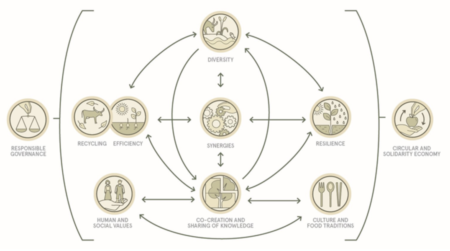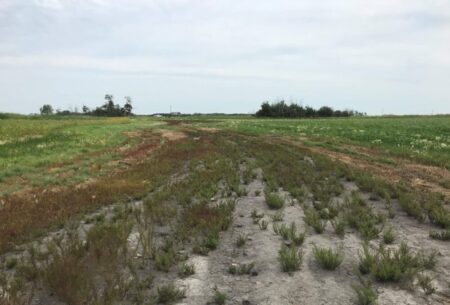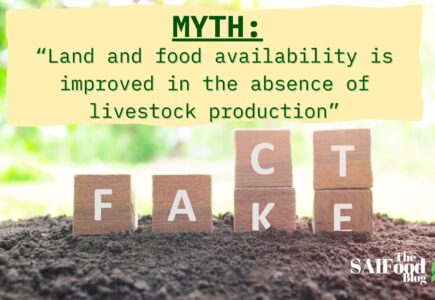Agriculture Myth Busting
There currently exists a global land competition problem. In the current trajectory, North American agricultural productivity will be facing very real challenges in the coming years, as the average Canadian diet requires nearly 130% of domestic agricultural land available (or, nearly 81 million agricultural hectares since Canada currently operates with 62 million hectares). Increased risk aversion in farmers and correlated farmland price increases suggest that expansion is unrealistic. Therefore, with a growing population and associated needs, humans are tasked with making more out of less available land. What little land remains unoccupied tends to be insufficient for crop production or too costly to convert to food production. Some land competition can be attributed to food-fuel tradeoffs (bioenergy crops are typically more resilient than food crops on poor-performing fields), nonetheless, Canada has spent the better part of the 21st century converting twice as many acres away from cropland as it restored.
These trends appear to be on par with specific agricultural challenges since the 1950s such as stricter soil science and classifications as technology advanced, and that value is lower than the average of G20 and European countries. However, it is predicted that global land-use shifts will need to take place to adequately meet the 2030 United Nations climate and productivity goals. One option that this blog will attempt to summarize is the idea that livestock production is taking up valuable crop space and therefore acres are distributed inefficiently; as a result, the absence of livestock will free land such that the growing population (and food security) needs can be met.

It is important that land be assessed holistically in order to best allocate available resources, as the availability of natural resources impacts managerial requirements and mitigation capabilities. Assessing what is feasible in a field via potential soil impacts is more important than trying to find a plot that fits management, especially given the potential that management decisions are one of the reasons for poorly-producing agricultural soils. Therefore, an agroecological approach is promoted (Figure 1) to accommodate productive limitations and assess all resource efficiency options.

This approach matters because not all farms are created equal. Not only do Canadian soils differ wildly within provincial borders, but the perception of what productivity challenges exist, let alone which solutions are financially viable, also vary. Even the perception of ‘marginal land’, despite there being a national standard for agricultural land capacity, is farm-specific. However, agrologists generally agree that marginal lands are an underutilised resource for meeting growing agricultural needs and mitigating climate change effects.
Marginal Land, Decent Opportunity
Generally, marginal land refers to that which is unsuited for sustained agricultural production. Approximately 10% of all agricultural land is classified as ‘marginal.’ It is the sustained technicality in that definition that separates marginal from unproductive: marginal lands can be improved to be productive but its limited productivity can also be worsened. The restoration of marginal status to an agriculturally productive one is a lengthy process as, really, farmers are building land capability rather than guaranteeing performance. Performance is rarely guaranteed in agriculture. Similarly, productivity improvements are not ensured and sustainable land use (i.e. effective/efficient resource distribution; efficient land use) does not ensure climate sustainability.
The complexity of soil suggests that best management practices can only ever improve potential. Using marginal land not only increases the number of arable acres available for food production (effectively improving land use efficiency, when executed appropriately) but also improves soil quality and carbon sequestration potential, though not immediately. To clarify, cropland – even well-performing cropland – has the lowest average soil carbon sink capacity amongst land types. Creating permanent cover on those marginal lands ultimately builds the soil nutrition and biodiversity networks that can support future crop production; the degree and speed to which these effects improve a farm is dependent on management and species selection. For example, adding nitrogen to a field reduces the sink capacity by about 11% while applying nitrogen with phosphorus only reduces uptake by about 5.7%. If every acre of marginal Canadian land were to be replaced by willow trees to improve sequestration capacity, the nation could theoretically offset 8% of our greenhouse gas emissions. In many ways, the marginal land use discussion is one indirectly linked to climate change opportunity, which, in turn, prompts the conversation in a livestock direction.

Marginal lands are an amazing resource for livestock production as the soil cannot adequately or efficiently produce crops. The benefits of grazing to soil health are well documented, including here on SAIFood, and grazers can add value to unmarketable crops, like the grass and forage species required at the beginning of marginal land restoration. Beyond ecological reasons, the historical pattern of grassland degradation provides an opportunity to culturally revitalize the prairies. For example, the reintroduction of bison to Saskatchewan in both Wanuskewin and Batoche historic sites improves natural grassland plant-animal life cycles and the Indigenous culture and education that already valued livestock on the land.
A Meaty Defense
Over the last 60 years, global meat consumption has doubled in response to increasing global incomes whereas livestock-related emissions have dropped by more than 11%. This is a testament to the productive improvements made to livestock production – especially in North America – where beef is over a third more emissions efficient than the global average. Beef, however, is still an emissions-intensive product, more than seven times that of chicken, and requires more than 74 times the amount of land per 100g protein as tofu. While progress has been made, it is difficult to ignore such environmental gaps in protein, which is perhaps part of the reason “just be vegetarian” is used as a climate position.
However, because of physical land constraints, the majority of agricultural land is ill-suited for crop production, making the effect of most field use shifts negligible from a sustainability perspective since decreasing emission intensity does not automatically mean more land is available. Estimates out of the United States suggest that if every American were to completely eliminate animal proteins from their diets, greenhouse gas emissions would decline by less than 3%. Likewise, cropland starts wasting from lack of use when at least 60% of the diet follows a lacto-ovovegetarian regimen. The case for livestock removal is therefore unfounded, ignorant to the biodiversity and carbon storage benefits of grazing (including in marginal land restoration), the reality of global land availability, and the number of farmers who would be affected by such a radical suggestion.
Concluding Remarks
Beyond trying to convince policymakers of the (indirect) value of livestock, marginal land itself, is an undervalued resource. Best management practices in a variety of specialties have encouraged taking advantage of marginal land and building productive acres since the 1970s, but incentives that encourage employment do not adequately exist. In response to this trend and the low-performance certainty, the potential to sequester 1.7 million tonnes of carbon dioxide is left on the table as restoration costs outweigh potential productivity promises. If a low-carbon diet is a more environmentally sustainable solution to absolving our livestock industry, then farmers need to be informed of available options to meet those goals and efficiently incentivized to make appropriate changes.
Ducks Unlimited recently started a program paying farmers per marginal acre that is converted to permanent forage cover for the next ten years and the Saskatchewan Soil Conservation Association offers rebates for similar forage coverage plans; the Saskatchewan Stock Growers Foundation offers conservation easements for land protection for twice the length of time as other programs. The variety of programs available suggests not only farmer interest in soil conservation, but also option availability depending on farm-specific requirements and limitations. While these programs are steps in the right direction to ensure agricultural land use is maximized but carbon intensity minimized, more cost-sharing programs need to be available to farmers, especially when discussing such a long timeline to observe benefits.
This is not to say that restoring marginal lands is viable for every farmer, either financially or physically. Rather, this emphasizes the variability in farms and soils and the necessity for a wider range of land restoration program options. A paper out of China suggests that the global norm will eventually be high productive capacity on marginal soils but at an incredibly high environmental cost, either from agricultural inputs (which further degrade yield capabilities) or from restoration costs. Opportunities to meet changing land requirements and capabilities exist but the accessibility does not, leaving marginal lands and their benefits lost to a society increasingly concerned with growing food needs and climatic uncertainty.

